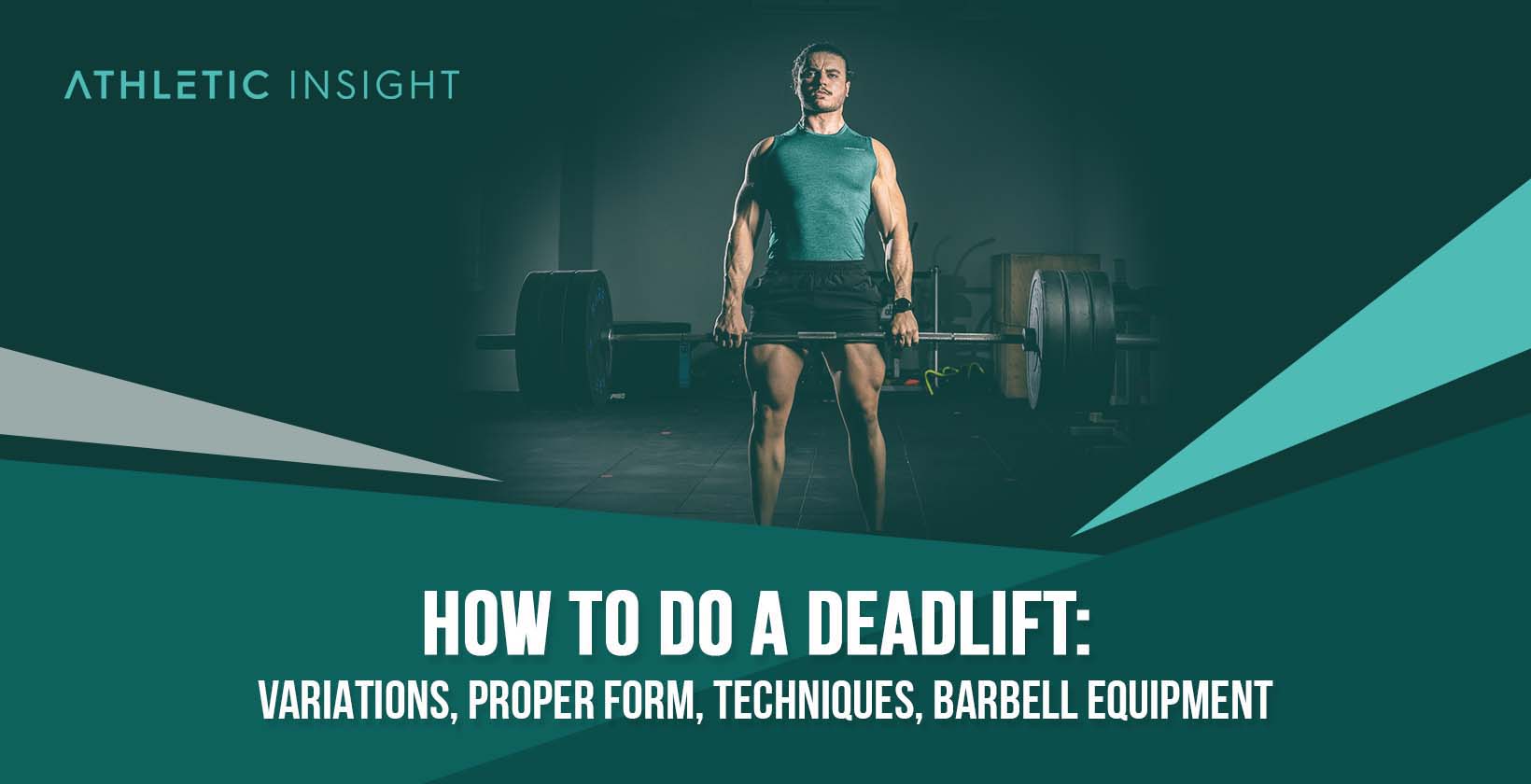The deadlift is an exercise that works several muscle groups to increase strength, mass, and overall power. This compound lift works both the upper body and lower body while providing some cardiovascular benefits because it increases the heart rate.
Adding a deadlift into an athlete’s workout offers several benefits. Aside from working for multiple muscle groups and boosting cardiovascular activity, the exercise mimics a natural bodily movement, making it easier for new lifters to master deadlifts. Since it’s also possible to adapt and increase the lift’s difficulty, the deadlift could be the ideal exercise for athletes of all levels.
When performing a proper deadlift, athletes work the muscles in the legs, core, and back. More specifically, the deadlift works the quads, hamstrings, gluteus maximus, hip flexors, abs, traps, and lats. This exercise allows athletes to increase grip strength and balance the work they do on mirror muscles, the chest, abs, and quads to create a more balanced physique.
Note that there are various deadlift techniques and adaptations to increase the lift’s difficulty, but lifters should master the traditional barbell deadlift before experimenting. The barbell deadlift uses a barbell and plates. Athletes engage their hips, thighs, core, and back to lift the bar from the ground.
Maintaining proper form is crucial to working the muscles and joints properly. The proper barbell deadlift form keeps the back flat and the bar under control at all times. Athletes should stand with their feet even with their shoulders. Grab the bar with hands slightly wider than the shoulders.
There are 10 variations of the deadlift, including the traditional version, the barbell rack pull, the Romanian deadlift, snatch-grip deadlift, trap bar deadlift, deficit deadlift, sumo deadlift, single-leg Romanian deadlift, straight-legged deadlift, and American deadlift. The different variations alter grips and equipment to work muscles in unique ways.
The main deadlift mistakes involve poor form, using too much weight, and jerking instead of using controlled movements. Perhaps the most common mistakes with form are foot placement and rounding the back.
Though the deadlift is a popular exercise, injuries happen more often with this lift than any other. Common injuries include muscle sprains and tears, mostly in the lower back and hips.
Using proper form is critical to preventing injuries and making gains. Injuries generally occur because the lifter uses too much weight or rushes through the exercise.
How to Perform Deadlift with Proper Form
Proper deadlift form is essential to preventing injury and working the target muscles properly. Since the deadlift form mimics a basic human movement, it’s easy to break the process into a few steps.
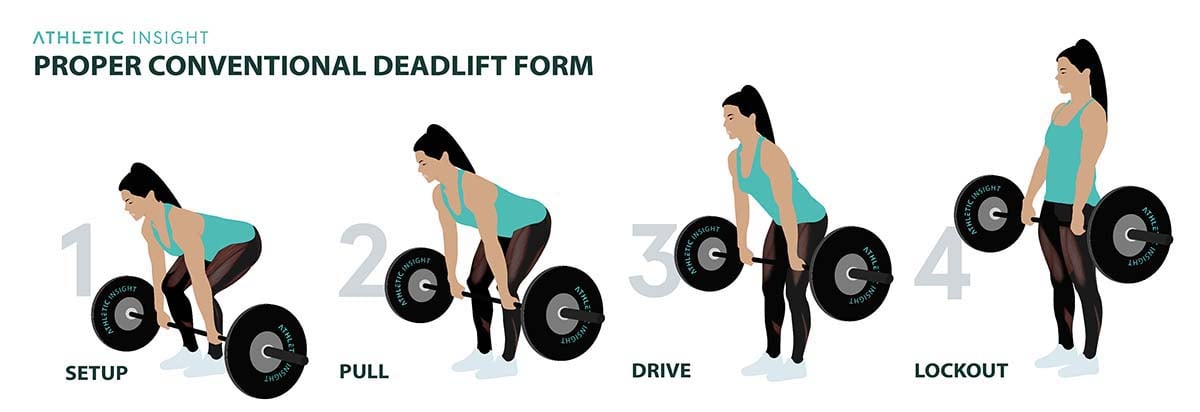
Correct deadlift form includes three main steps:
- Setup, including stance and grip
- Driving the legs to the ground while pulling upward
- Lockout is the top of the motion where athletes pause before returning to the starting position
Knowing how to deadlift properly is the key to making gains and staying healthy. Athletes must learn good deadlift form before moving on to any adaptations, which may mean starting with much lighter weights.
What Are the Parts of Conventional Deadlift?
Understanding the stages of conventional deadlifts is key to perfecting good form. Performing a deadlift requires slow, controlled movements instead of fast, jerking motions. If a lifter doesn’t understand each step, it’s impossible to perform them slowly and correctly.
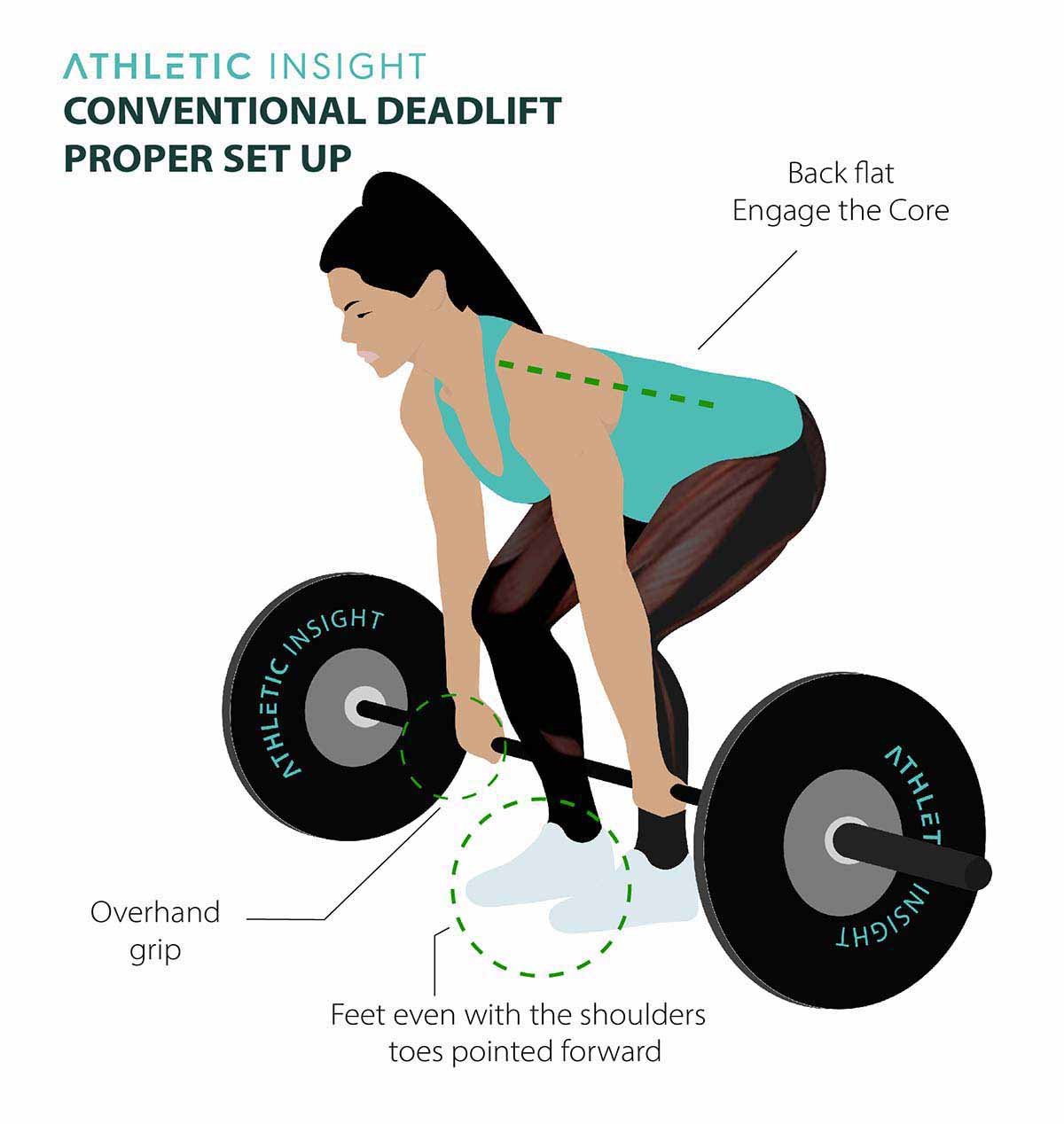
The conventional deadlift, also known as the traditional deadlift or barbell deadlift, is the easiest to learn. Athletes only require a barbell, but they can increase the weight by adding plates and securing them with lifting collars or clips.
The main parts of a conventional deadlift include the following.
- Setup
- Drive
- Lockout
1. Setup
The setup stage might be the most important part of the exercise because it’s the foundation for everything that comes after. It’s all about establishing the proper stance and grip to guide the lifter through the deadlift. Rushing through the setup often results in an inefficient starting position. A weak starting position can prevent a good lockout and even lead to injury.
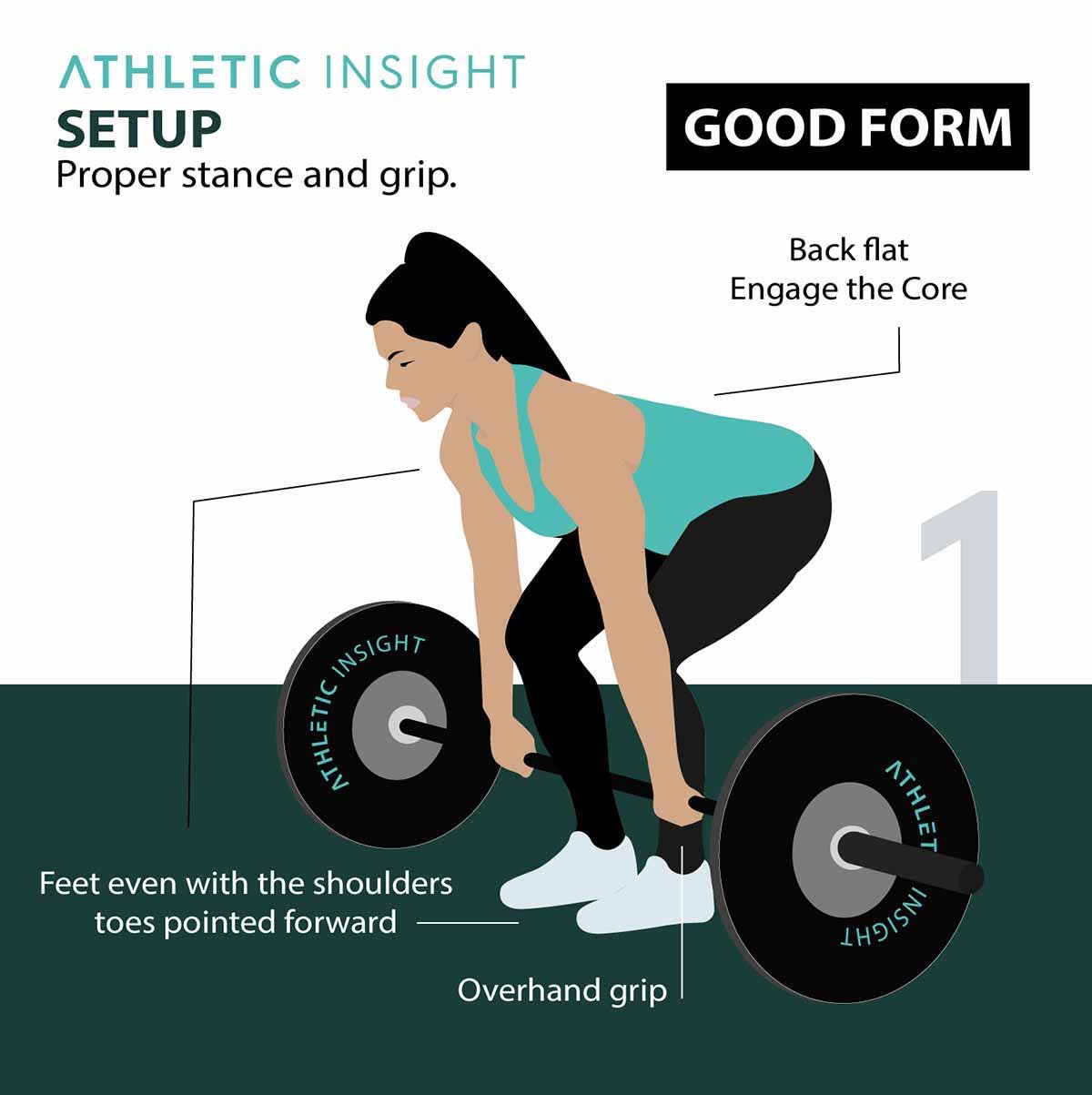
Possible mistakes for the setup phase include a rounded back, weak or inefficient grip, and an unbalanced stance. All of these issues lead to inefficient motions that prevent proper activation of target muscles, weaken the overall exercise, and can result in injury.
Proper setup for a conventional deadlift should include the following.
- Stance
- Grip
- Engage the Core
1. Stance
For a conventional deadlift, the typical stance means keeping the feet even with the shoulders and toes pointed forward. It’s important to find balance in the stance before moving on. Don’t put too much weight on the heels or toes; instead, keep it more equal for support throughout the exercise.
Note that advanced lifters often alter their stances but they usually have the strength and balance to complete the maneuver with their feet closer together or wider apart.
2. Grip
The conventional deadlift form uses an overhand grip. Athletes should place their hands so that their arms are just outside the shoulders, knees, and feet.
3. Engage the Core
Engage the core muscles for support and keep the back straight. Since rounding the back can lead to injury, setting up with the back flat and core engaged is crucial. This approach also extends the spine, which makes the initial movement challenging for the legs and easier to reach lockout.
2. Drive
The drive stage involves lifting the bar off the ground. It should be one smooth motion that utilizes a combination of leg drive with core and back strength. The arms should not do any of the work, other than guiding the bar up the shins and over the knee. Instead, focus on driving with the legs to move the bar.
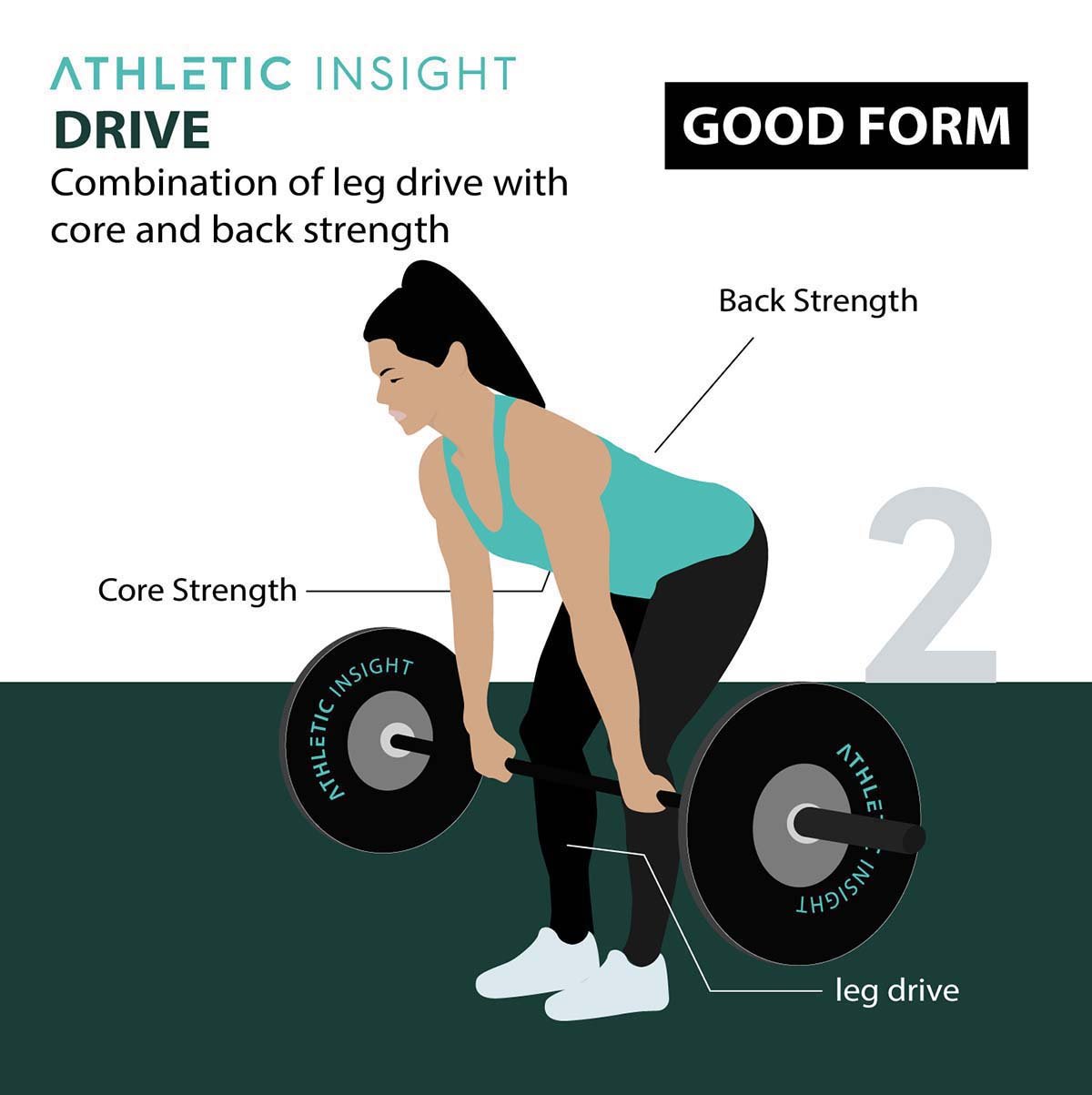
3. Lockout
The lockout stage is the part of the exercise where the lifter takes the bar from the knees upward. Once the bar reaches the knees, the athlete needs to thrust with the hips and bring the chest up to complete the motion. The back and arms should be completely straight for two seconds before gradually lowering the bar back to the ground.

What Are the Mistakes for Deadlift Form?
The biggest mistakes with conventional deadlift forms involve the feet, the back, and the shoulders.
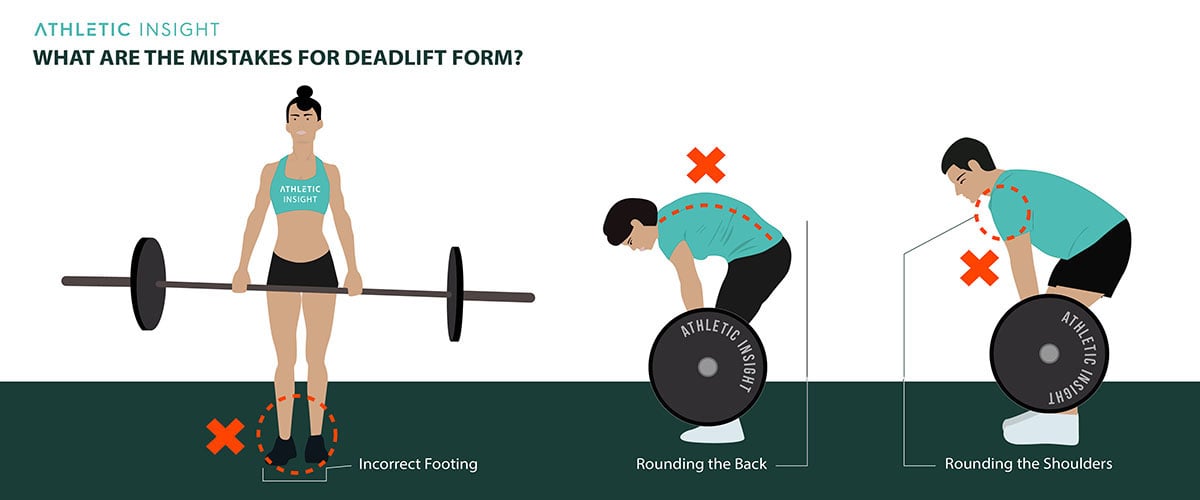
- Incorrect Footing
- Rounding the Back
- Rounding the Shoulders
1. Incorrect Footing
Good deadlift form starts with a proper stance. Unless the lifter is experienced, it’s best to keep feet shoulder-width apart with weight evenly distributed between the balls of the feet and the heels.
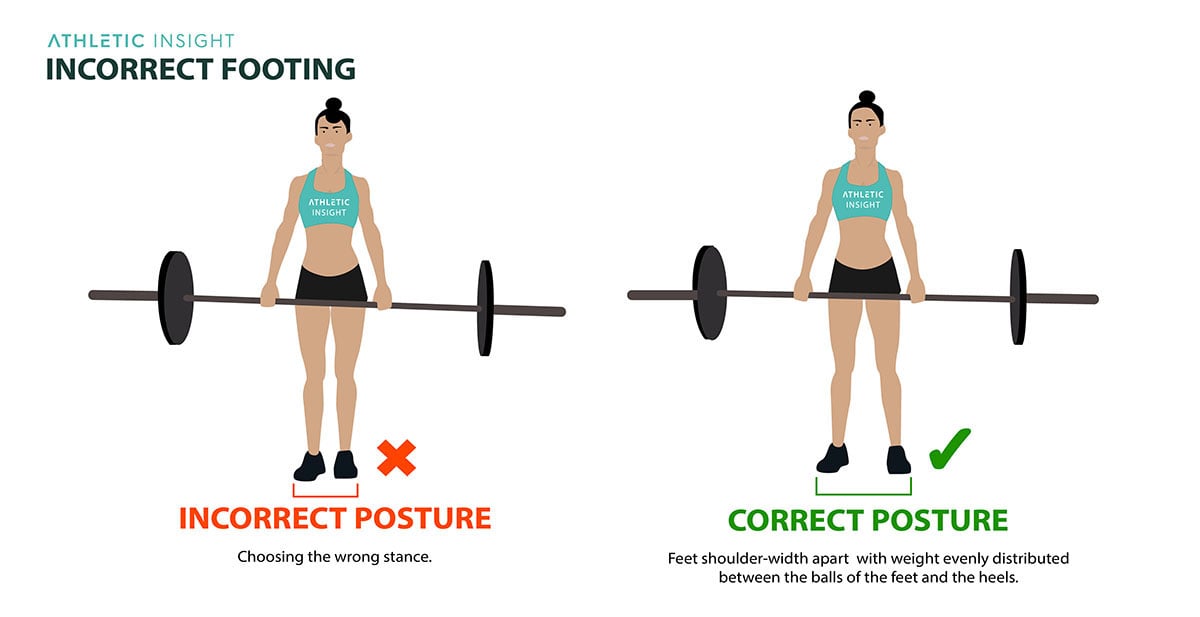
2. Rounding the Back
Keeping the back flat or in a neutral position prevents the athlete from putting too much pressure on the low back, which can lead to injury. Lifters who round or arch the back put undue stress on the spine and back muscles.
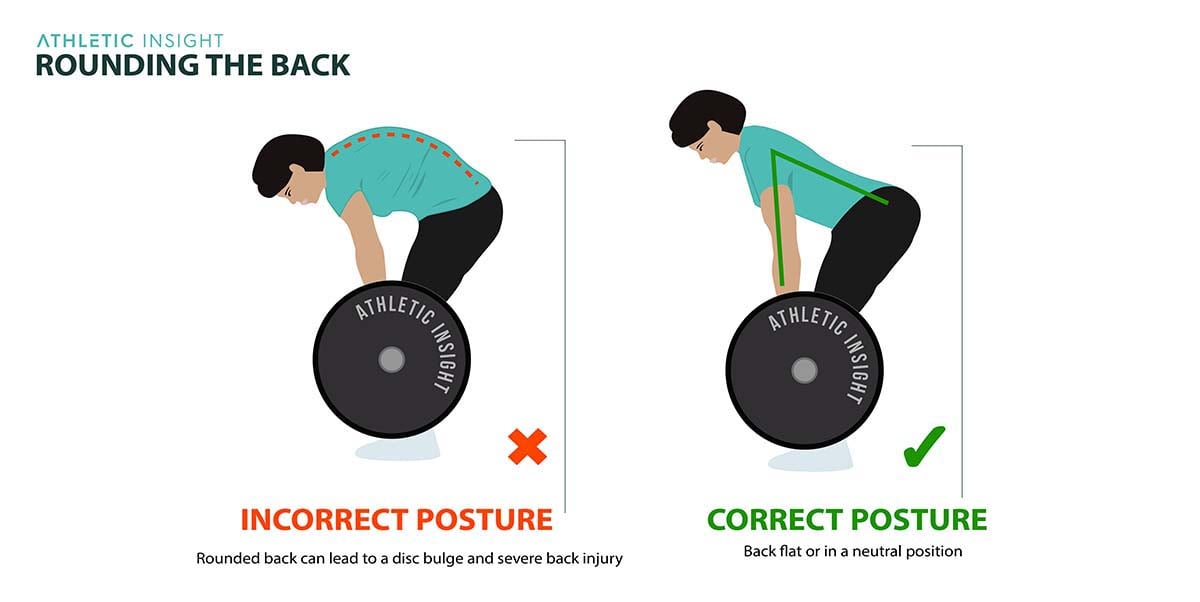
3. Rounding the Shoulders
Another part of a good deadlift form involves pulling the shoulder blade together to support a neutral spine. When athletes round the shoulders forward to lift the weight, it stresses the spine and surrounding musculature.
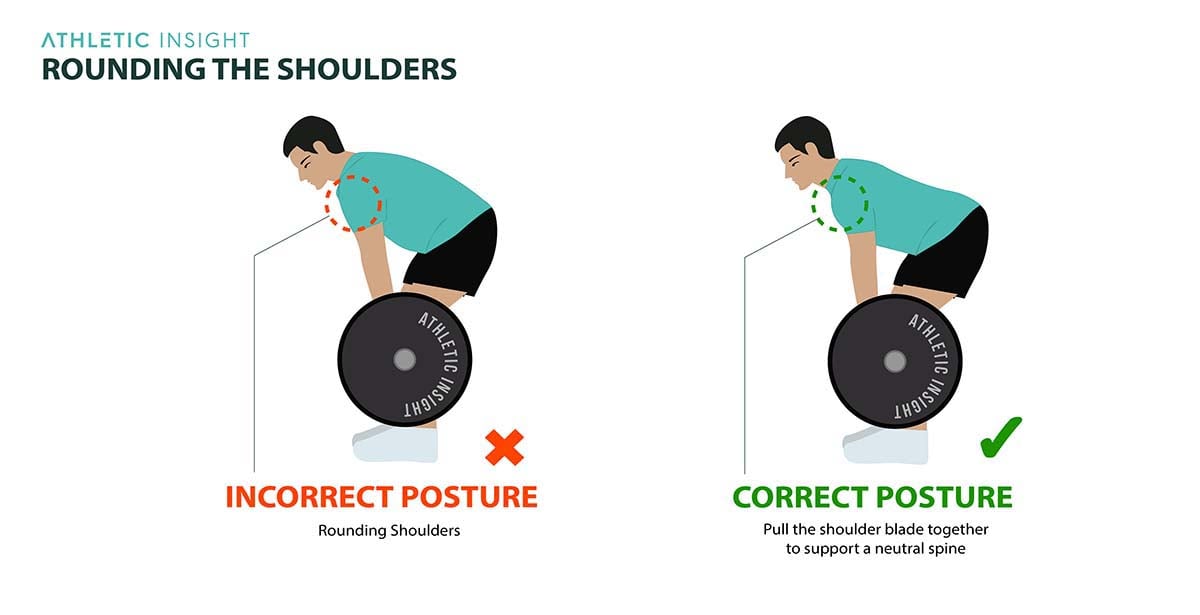
How to Determine Proper Weight for Deadlift
Determining the proper weight for a deadlift can be tricky. Overall strength level, skill level, weight, and gender typically factor into the decision.
Beginners should start with just the bar so that they can focus on proper form. It’s never a good idea to compromise any aspect of form to lift more weight.

Once an athlete masters proper deadlift form, it is time to add weight to the bar. Women may want to start by lifting their weight and men could try to lift their weight plus a third.
Intermediate and advanced lifters who have more strength and experience can increase their weight between 150% and 200% of their body weight for men and 110% to 160% of their body weight for women.
Elite athletes have been known to deadlift more than twice their body weight. Athletes at this level typically have spent years building strength and perfecting the deadlift form to accomplish this feat.
What is the Importance of Grip for a Deadlift?
Grip strength is a key factor in performing a successful deadlift. The grip is the way the hands hold the barbell throughout the exercise. Good grip strength allows the athlete to hold the bar longer and keep it steady.
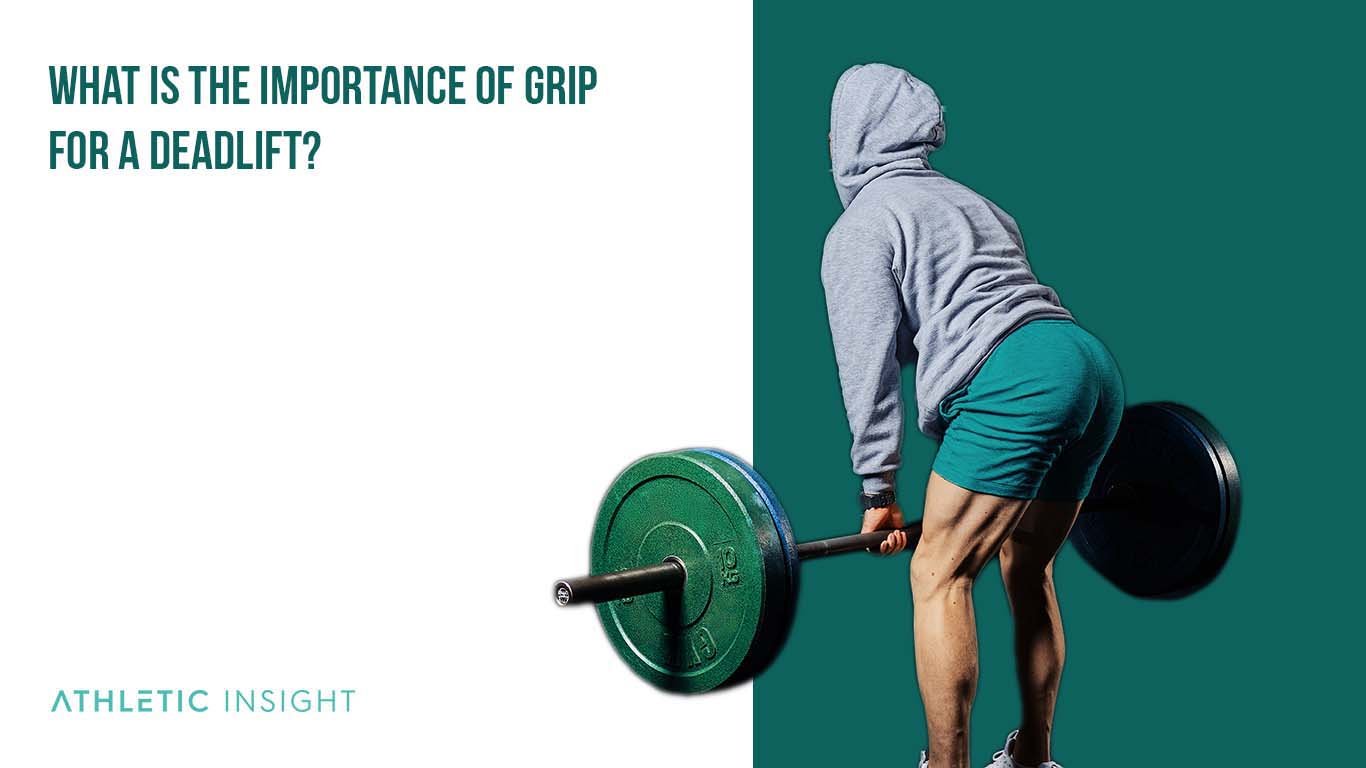
As athletes progress with their deadlift form, it’s possible to attempt different grips to make the exercise more difficult. Adjusting the grip can also work the muscles in different ways to create a more comprehensive workout.
Which Muscles Are Involved While Performing Deadlift?
The deadlift is a compound exercise because it works several muscle groups and joints. It’s an excellent way to round out an ab circuit or back routine, but it really engages the legs and butt.
The muscles involved in performing a deadlift include the following.
- Glutes
- Lats
- Hamstrings
- Abs
- Quads
- Spinal Erectors
- Traps
1. Glutes
The glutes do more than their share of work during a deadlift, especially a gluteus maximus. When using proper deadlift form, the glutes do the lion’s share of the work to move the bar up and down. The further down the hips start, the more work it takes to straighten the legs, and the more the glutes have to do.
2. Lats
Engaging the lats makes it easier to keep the back straight and limits the use of the arms during a deadlift. When athletes engage the lats during a deadlift, it’s easier to maintain proper form and it works the muscles throughout the upper back and shoulders without straining the spine.
3. Quads
Athletes use the quadriceps to extend their knees. That means the quads do the most work during the first part of the exercise, moving the bar up to the knee.
4. Hamstrings
The hamstrings do a lot during a deadlift. They support the knee joints throughout the exercise and stabilize the glutes as the bar passes over the knee and into the lockout position.
5. Abs
Athletes must engage the abs to stabilize their bodies during a deadlift. Since the abs support the center of the body, they provide tension for the spinal erectors to keep the back in a neutral position throughout the lift.
6. Spinal Erectors
Athletes engage the spinal erectors to keep their backs straight throughout the exercise. The spinal erectors support the spine as the lifter transitions from starting position to standing and back down to the ground.
7. Traps
Engaging the traps throughout the lift provides support for the shoulders. Squeezing the traps keeps the shoulders in the proper position without straining the spine.
How to Master Deadlift
The deadlift is one of the most popular exercises among athletes and trainers. When performed correctly, the compound exercise works the entire body. It also serves as a marker of overall strength, so it’s no surprise that most lifters want to master the exercise.
To dominate deadlift, follow these steps.
- Do Not Break the Form
- Lift for the Results
- Breathe Correctly
- Feel the Muscle
- Use Your Shins
- Use Deadlift Belts
- Improve the Grip Power
1. Do Not Break the Form
Maintaining proper deadlift form through the entire exercise is essential. The benefits include injury prevention and isolating all of the target muscles at each point in the process.
When athletes break from proper deadlift form it can lead to muscle or joint damage. For example, arching or rounding the back can put excess stress on the spine and lower back muscles leading to strains and even slipped discs. Additionally, a rounded back means the lifter doesn’t make gains with the target muscles.
Another example that demonstrates the importance of maintaining a good deadlift form is using an incorrect stance. Poor foot position and incorrect weight distribution can throw the entire motion off, leading to instability and overcorrection which tend to result in muscle strains and tears.
2. Lift for the Results
Lifting for results means focusing on the gains instead of the amount of weight lifted or reps completed. Athletes should determine what their goal is before determining the amount of weight to lift and how many reps to complete.
The benefits of committing to this approach include having a more refined and focused workout. For example, the deadlift works for multiple muscle groups and allows the athlete to isolate each muscle group at some point in the lift. Choosing a lighter weight so that the lifter can feel each muscle group engage ensures they make the most overall gains.
Conversely, a bodybuilder seeking to increase the amount of weight they deadlift might take a slightly different approach. They may choose a heavier weight and go through the movement slower to identify their weakest muscle groups. Then, the lifter can focus on building those muscles to improve their overall lift and increase the amount of weight they can handle.
3. Breathe Correctly
Breathing correctly may sound like silly advice since everybody needs to breathe to survive. However, breathing correctly during an exercise improves its effectiveness by supporting the core and helping the body work more efficiently.
Benefits of breathing correctly during a deadlift include increased core stability and a safer lift. It is one of the most important things an athlete can do to generate the power necessary to lift the bar.
It’s best to inhale at the start of the lift to engage the muscles throughout the core. Exhale during the pause of the lockdown phase. Inhale for support before lowering the bar back to the ground.
4. Feel the Muscles
Feeling the muscles means having an awareness of the body as it moves through each part of the exercise. The benefits of feeling the muscles are that an athlete can engage each target muscle properly and identify any areas of weakness.
For example, an athlete slowly lifts the bar but notices that it’s difficult to keep the back and spine in proper position. That indicates weakness in the spinal erectors, and the athlete can take extra care during their ab circuit to strengthen those muscles.
5. Use Your Shins
Using the shins means rolling the bar up the shins to the knee. Keeping the bar in line with the shins is beneficial because it supports balanced and proper form by serving as a guide.
Stepping up to the bar until the shins touch it is a common guide for new deadlifts, but it shouldn’t lead to injuries. The bar should roll lightly over the shins with the legs, core, and back doing the work. The shins merely provide a guide to keeping the lifter on track and should not result in bleeding or bruising, no matter how heavy the weights might be.
6. Use Deadlift Belts
A deadlift belt is a supportive device that lifters use to maintain proper form and reduce the chances of back injury. The belt wraps around the midsection to support the lower back during the deadlift. In fact, it’s generally only used during squats, deadlifts, or other exercises that could cause hyperextension of the back.
It’s beneficial to use a belt during deadlifts to prevent the athlete from stressing the lower back during the lift. Additionally, weightlifters moving to higher weights can handle it more easily with a belt to support the back and core.
7. Improve the Grip Power
Improving grip power increases the strength of an athlete’s grip. It’s beneficial because they can hold the bar longer and ultimately experiment with more difficult grip arrangements.
For example, if an athlete increases their grip strength, they may be able to pause longer at the top of the lift to feel more work in the muscles at that juncture. Or, the athlete might swap to a completely different grip that requires more strength but works the muscles differently.
What Are the Deadlift Challenges?
Deadlift challenges sound scary, and they may not be the best choice for beginners. However, these challenges can help athletes make serious gains in mass, strength, and endurance.
The features of deadlift challenges include pushing the body to correctly form the lift in different ways. It’s crucial that the athlete maintain proper form for every rep, but the approach to sets and reps differ in terms of times, rests, and the amount of weight used.
- Deadlift and EMOM
- Deadlift and GVT
- Test the 1RM with Deadlift
1. Deadlift and EMOM
What is EMOM? It means every minute on the minute. While it’s not specific to the deadlift, connecting this challenge to the deadlift can have significant benefits for an athlete. First, the deadlift works the whole body, so doing the EMOM challenge does a lot of work in a short time.
To do the EMOM challenge with a deadlift, select a manageable weight, even if it’s just the bar. Most lifters don’t go over 65% of their weight. Do as many reps as possible for half a minute, rest half a minute, then go again for ten minutes straight. This challenge builds endurance and gets your heart going for a cardio benefit.
2. Deadlift and GVT
German Volume Training commonly referred to as GVT is all about building strength. Connecting the GVT challenge with the deadlift is an excellent way to quickly build overall strength.
For example, the athlete should choose a lighter weight, about 60% of what they normally lift. Try to do 10 sets of 10 reps with 90 second rests between each set. The benefit of this challenge is to increase the amount of weight an athlete can lift, which in turn builds muscle.
3. Test the 1RM with Deadlift
The 1RM or one-rep max tests a lifter’s strength by seeing how much weight they can lift for one rep. It’s a graduated challenge that connects well with the deadlift because it’s all about building strength. Combining the 1RM with the deadlift is an excellent way to build several muscle groups at one time.
The ideal approach to the 1RM starts with 2 to 3 reps at half the athlete’s normal deadlift weight. Add 10 to 20kg and do 2 to 3 reps. Continue this pattern until the athlete fails to complete one rep. At that point, the last completed rep is the athlete’s 1RM. It’s beneficial because it is the best way to get stronger and focuses on lower reps and proper form.
What Are the Deadlift Variations?
There are several deadlift variations. The most common variations include the traditional barbell deadlift, barbell rack pull, Romanian deadlift, snatch-grip deadlift, trap-bar deadlift, deficit deadlift, sumo deadlift, single-leg Romanian deadlift, straight-legged deadlift, stiff-legged deadlift, and American deadlift.
Each variation of deadlift works for the same muscle groups in slightly different ways by changing the grip, stance, or equipment. Using a wider stance or different bar helps the lifter engage muscles in unique ways and even isolate some of their weaker errors to get a more balanced lift.

For example, the sumo deadlift adopts a wider stance. This adjustment puts more emphasis on the knee joints and works the quads from a different angle. It also improves hip mobility and addresses the glutes in a new way.
One of the biggest features of working in some deadlift variations is a change in routine. Lifters can work weaker areas and accessory muscles that don’t get as much action in the traditional deadlift.
- Barbell Deadlift
- Barbell Rack Pull
- Romanian Deadlift
- Snatch-Grip Deadlift
- Trap Bar Deadlift
- Deficit Deadlift
- Sumo Deadlift
- Single-Leg Romanian Deadlift
- Stiff-Legged Deadlift
- Straight-Legged Deadlift
- American Deadlift
1. Barbell Deadlift
The barbell deadlift is the traditional version of the exercise.
To properly perform the traditional deadlift, the lifter should stand with feet even with the shoulders. Facing the bar, bend at the waist to grasp the bar with arms just outside the shoulders and knees. Bend the knees to lower the hips. Engage the core and keep the back neutral. Lift the bar, sliding over the shins and knees up to a standing position.
The most common mistakes for a traditional barbell deadlift involve poor form. Incorrect foot placement, rounding the back and failing to engage the shoulders properly reduce the efficacy of the lift and can lead to injury. It’s necessary to maintain proper footing for balance, engage the shoulders, and keep the back neutral to avoid undue stress on the lower back.
For this type of deadlift, the athlete only needs a barbell. Most lifters also use plates to add weight and collars to secure the plates on the bar.
The conventional deadlift works the glutes because of the emphasis on the hip hinge, but it does wonders for the entire posterior chain. An athlete’s hamstrings and quads work hard through the entire lift. The erectors, rhomboids, traps, lats, and core serve as accessory muscles providing support and stability throughout the exercise.
Compared to the sumo deadlift, the barbell deadlift focuses more on the hip hinge. Further, the traditional barbell deadlift establishes the foundation for learning how to lift the dead weight from ground level. In comparison, the sumo deadlift requires an athlete to master the traditional motion and enough flexibility in the hips to manage the exercise.
2. Barbell Rack Pull
The barbell rack pull is a variation of the deadlift that starts with the barbell on a power rack or blocks. This variation has the athlete lift the bar from around knee height, reducing the range of motion and allowing lifters to add more weight. It also improves grip strength.
To properly perform this lift, the athlete should set up a barbell on a rack. It should be around the same height as the athlete’s knees. With feet even with the shoulders and hands just outside the knees, grasp the bar. Engage the muscles through the core and back to thrust the hips forward and pull the bar up. Hold for a few seconds, then return to the starting position.
The most common mistakes with the barbell rack pull are related to poor form. Even though this variation doesn’t lift the dead weight from the ground, it uses the same basic principles and movements as a traditional deadlift. Therefore, it requires the same attention to form, like a neutral back and engaged core.
For this variation, athletes require a barbell with weights secured by collars. Additional equipment includes a power rack or stable support that elevates the bar off the ground to a proper level.
The rack pull primarily engages the glutes, but it works the upper back muscles, especially the traps, more than other variations. Like other deadlift variations, the rack pull still activates the hamstrings and quads for stability and joint support.
Compared to the traditional deadlift, the barbell rack pull leaves less room for stressing the lower back. Since the lifter doesn’t have to pull from ground level, it’s easier to work on proper form and preserve the lower back.
3. Romanian Deadlift
The Romanian deadlift is a variation that is almost a reverse of the traditional version. Lifters start in the standing position and bend at the knees and hips to lower the weight before driving back up to a standing position.
To perform a Romanian deadlift, athletes should hold the bar with an overhand grip and arms just outside the hips. With knees slightly bent and keeping the back straight, the athlete should hinge at the hips to lower the bar. Lifters should pause when they feel the hamstrings stretch then thrust the hips forward to lift back up to a standing position.
Possible mistakes with this variation include using too much weight to maintain proper form and putting too much pressure on the back. Athletes should only use as much weight as they can handle and keep the back neutral to avoid stressing the lower back.
Athletes can add Romanian deadlifts to different workouts because they do wonders for the glutes, core, and back, but the star muscles for this exercise are the hamstrings. Romanian deadlifts allow lifters to isolate the hamstrings to build strength and flexibility. These Romanian deadlifts only require a barbell with plates secured by collars.
Compared to the traditional deadlift, the Romanian variation doesn’t require lifters to use a lot of weight to see results. Romanian deadlifts allow athletes to progress with lighter weights, and it’s even effective with heavy items found around the house.
4. Snatch-Grip Deadlift
The snatch-grip deadlift changes the athlete’s grip on the bar to put more emphasis on the upper back muscles. It’s a more complex lift that forces the lifter’s muscles to work harder.
Proper form for the snatch-grip deadlift starts with the stance. Lifters should experiment with the distance between feet that provides the most comfort and balance. The athlete should use a wide grip on the bar. Bend the knees, straighten the back, and lift the bar, sliding it up the shins like a traditional deadlift. Pause in the standing position for a few seconds then lower the bar.
Possible mistakes for this version involve poor execution. Lifters might thrust the hips too early if they start too low. Another potential problem is letting the bar drift too far from the body.
The necessary equipment to perform a snatch-grip deadlift include a bar with properly secured plates.
The snatch-grip deadlift engages the upper back and glutes while using the core, hamstrings, and quads for support and stability. Additionally, lifters can see some improvement in flexibility of the ankles, knees, and hips.
Compared to the traditional deadlift, the snatch-grip variation requires more grip strength to manage the wider grip. It’s also more complex and pushes all muscle groups to work harder, especially the upper back.
5. Trap Bar Deadlift
The trap bar deadlift uses different equipment. Instead of a traditional barbell, the trap bar utilizes a specialized bar with a frame and handles. The lifter steps into the closed frame and grasps handles to lift the bar.
To correctly perform a trap bar deadlift, the lifter should adopt a comfortable stance that works within the trap bar’s constraints. Grasp the handles, knees bent, hinged at the waist, and keeping the back straight, lift the bar. Pause in the standing position for two seconds then lower the bar.
Possible mistakes for this variation include an improper setup and using too much weight for the lifter’s fitness level. Keep the back flat and engage the core muscles to complete this lift properly. Lifters may have to experiment with weight to find an acceptable level that allows them to complete the lift without losing form.
The necessary equipment for a trap bar deadlift is a trap bar, also known as a diamond or hex, and weight plates secured by collars.
The trap bar deadlift works the glutes and allows the lifter to target specific muscles at each stage of the lift. Additionally, the athlete works the hamstrings, quads, erectors, and traps.
Compared to the traditional deadlift, the trap bar variation allows the lifter to focus more on the pulling motion. It’s an excellent way for newer lifters to master the basic deadlift motion, but it also helps experienced lifters increase their max weights.
6. Deficit Deadlift
Deficit deadlifts are any deadlifts where the athlete uses an elevated surface to increase their range of motion. It creates a challenge at the beginning of the lift to add complexity to the exercise.
Since any deadlift variation can work with the deficit deadlift, the form should follow the deadlift variation the lifter plans to perform. For example, if the lifter chooses to do a deficit deadlift with the sumo deadlift, they would observe the standard form for a sumo deadlift, but while balancing on an elevated surface.
Possible mistakes for this lift include using too much weight or lacking the stability to complete a more advanced maneuver. Athletes should have excellent mastery of the deadlift variation they plan to use before attempting a deficit lift.
The equipment required for this variation would be the bar and weights plus something to elevate the lifter. Common equipment includes a board, wooden blocks, bumper plates, or weight plates.
The deficit deadlift works all of the muscles the athlete would work prior to adding the elevation. Adding elevation makes the first part of the lift more difficult and requires more focus and balance to complete the exercise with proper form.
It’s important to understand that the deficit deadlift is a way to enhance any other variation of the deadlift. Unlike most of the other variations, this lift is not beginner-friendly and requires skill and focus to complete the deadlift properly while standing on an elevated surface.
7. Sumo Deadlift
The sumo deadlift is a variation that uses a wider stance with the arms inside the knees.
To perform a proper sumo deadlift, stand with feet wider than the shoulders and toes pointed outward, toward the plates. The arms should go inside the knees with shoulders over the bar. The back should remain flat and the core engaged. The athlete should lift the bar, pulling until they reach a standing position. Pause, then lower the bar to the starting position.
Possible mistakes for the sumo deadlift include rounding the back, which puts too much stress on the spine and setting the feet too wide. While it’s intended to be a wider stance, it should not cause pain or impair the lifter’s balance.
The necessary equipment for this variation is a barbell with weight plates secured by collars.
Like other deadlift variations, the sumo deadlift works those glutes, but it puts some more emphasis on them since the hips have a more external rotation with a wider stance. It also works the hamstrings, quads, erectors, and traps.
The sumo deadlift is often compared to the Romanian deadlift because of the extra work on the hamstrings. However, the Romanian deadlift works the hamstrings more, while the sumo variation offers a little extra to the glutes and generally allows the athlete to put up more weight.
8. Single-Leg Romanian Deadlift
The single-leg Romanian deadlift is a variation of the Romanian deadlift where the athlete balances on one leg while completing the lift.
Proper form for the single-leg Romanian deadlift involves starting in a standing position holding the bar or dumbbells. Lift one leg off the ground and bend it at the knee. Then, lower the bar, hinging at the waist and extending the bent leg behind them. Athletes should pause when they feel the hamstrings stretch, then return to the starting position.
Possible mistakes for this exercise include using too much weight or lacking the skill or fitness level to manage the lift. This variation is extremely challenging and requires incredible balance, which may mean using less weight than an athlete typically uses.
Athletes can use the barbell with plates or dumbbells to perform this variation.
This variation primarily targets the glutes, quads, and hamstrings. It also engages the core and back.
The single-leg Romanian deadlift is a way to increase the difficulty of the standard Romanian deadlift. Compared with the standard Romanian deadlift, the single-leg variation tests the lifter’s core strength, balance, and coordination for more.
9. Stiff-Legged Deadlift
This variation involves limited bend at the knees and doesn’t require the athlete to take the bar all the way to the ground.
To perform the stiff-legged deadlift, athletes begin in the standing position with feet shoulder-width apart and the bar in an overhand grip. With knees slightly bent, hinge at the hips to lower the barbell. Keep the back straight and bar in line with the body. When the athlete feels the hamstrings stretch, pause, then return to the standing position.
Possible mistakes for this exercise include jerky movements and using too much weight. The athlete should be able to use slow, controlled movements for each rep to feel every muscle work. Too much weight tends to interrupt the fluidity and lead to jerking motions.
Athletes can choose between a barbell with plates or dumbbells for this deadlift variation.
This variation focuses on the glutes and hamstrings, but it also works on the core and quads.
The stiff-legged deadlift generally strikes up a comparison to the Romanian deadlift since they look similar and start in the standing position. However, the stiff-legged deadlift doesn’t flex the knees as much as the Romanian variation.
10. Straight-Legged Deadlift
The straight-legged deadlift involves performing a deadlift with straight legs. With no bend to the knee, the athlete faces a restricted range of motion.
The proper form for this variation is standing with feet even with the shoulders and legs straight. The knees should not bend at any point in this exercise. Athletes should hinge forward at the waist to lower the bar until they feel the stretch in the hamstrings and then return to the starting position.
The typical mistake for this exercise is rounding the back. Lifters should maintain a neutral back through the entire lift and only lower the bar as far as they can without bending the knees or rounding the back.
Equipment for this variation would be a barbell with plates secured by collars. Athletes may want to use less weight than they would for a standard deadlift.
The straight-legged deadlift works the hamstrings and glutes, but it also engages the lats, traps, and core.
Many people consider the stiff-legged and straight-legged variations to be the same exercise, but there is a distinct difference. With the stiff-legged deadlift, athletes have a slight bend to the knee compared to the straight-legged variation where the knees do not bend at all.
11. American Deadlift
The American deadlift is a variation that involves tilting the pelvis at the lockout stage.
The proper form for this variation starts in the standing position with the feet in line with the shoulders. Holding the bar with an overhand grip, bend forward by hinging at the hips. Lower the bar to the knee cap and pause before pulling the bar up again. At the top of the motion, squeeze the glutes and tilt the pelvis to lockout then relax back to the starting position.
Possible mistakes include using too much weight and letting the bar get away from the body. Like other variations, the American deadlift requires lifters to keep the bar close to the body throughout the lift for maximum benefit. Additionally, too much weight makes it difficult to maintain proper form.
The necessary equipment for an American deadlift is a barbell with plates secured by collars.
This variation does more with the pelvis to isolate the glutes and target the hamstrings. By working the pelvis into the deadlift, athletes do more with glutes. Additionally, the American deadlift works the upper back more while still engaging the core and quads.
The American deadlift is often compared with the Romanian deadlift because they are so similar. However, the American variation incorporates that pelvic thrust.
What Is the Necessary Equipment for Deadlift?
One of the best parts about adding a deadlift to a gym routine is the limited amount of equipment necessary. Most deadlifts only require three components.
- Barbell or Trap Bar
- Weight Plates
- Barbell collars
- Power rack (Rack Pull only)
1. Barbell or Trap Bar
Every version of the deadlift uses a bar. Most variations use the traditional barbell, but the trap bar deadlift requires a special bar.
2. Weight Plates
While beginners might stick with just the bar, eventually lifters advance to adding weight to the bar for a more difficult lift.
3. Barbell Collars
Barbell Collars secure the weight plates on the bar so that they don’t shift and disrupt the lifter’s balance.
4. Power Rack
A power rack is optional because it’s only used for the barbell rack pull. Other deadlift variations lift from the ground.
What Are the World Records for Deadlift?
A deadlift world record is defined as the heaviest weight successfully deadlifted by a person. Other records exist, including timed lifts and most repetitions.
While other agencies might list records at events, like the Olympics and other worldwide competitions, most people turn to the Guinness World Record committee. The Guinness World Records track and retain this record among their archives. To set a world record, the title must fulfill several requirements:
- Measurable by objective standards using a set unit of measurement. In the case of a deadlift, it would be kilograms or pounds.
- Breakable, meaning that others can challenge them. The deadlift record has been broken several times over the past several decades.
- Standardizable, meaning that the conditions are repeatable within certain parameters. For the deadlift, challengers use the traditional deadlift form.
- Verifiable so that it’s provable with accurate and true evidence. Somebody, usually a specialist in the area, must witness the act. It should also be recorded on video.
- Based on a single variable that can be easily measured, like weight.
- Better than anybody else in the world at that one title.
To break a Guinness World Record, an individual must choose a record to attempt and follow a specific path.
- Apply to Guinness for the chance to challenge the record.
- The Guinness World Record team sends applicants the guidelines and explains how to challenge the record and have it verified.
- Applicants must set a date and time, and arrange for specialists, photographers, and videographers to record the attempt.
- Submit it to the committee.
- Wait for certification or rejection.
The current record for a traditional deadlift is held by Hafthor Bjornsson. The strongman and powerlifter are known for his role as Gregor Clegane, “the Mountain,” on Game of Thrones as much as for his record lift of 501 kilograms (1,104.52 pounds).
Another variation of the deadlift has a world record listed with Guinness. Canadian powerlifter, Greg Austin Doucette, holds the world record for most weight lifted in a sumo deadlift at a staggering 9,130 kilograms. Additionally, American weightlifter, Raymond Saraiva holds the record for the most sumo deadlifts in a minute at 10,548.74 kilograms.
Women Deadlift Records
Becca Swanson, an American powerlifter and pro wrestler set the record for the women’s heaviest deadlift at 290.5 kilograms on June 4, 2005. Several women have tried since, but nobody has managed to break it yet.
The world records for women aren’t as prolific among Guinness World Records. To find the women’s record, one has to look to the World Powerlifting Congress (WPC), an international federation established in 1986. The WPC maintains records for various weight classes dating back to 1987.
Guinness World Records does list one women’s record for deadlift. American Linh Nguyen completed the heaviest sumo lift (4009.57 kilograms) on October 1, 2020.
One final women’s deadlift record that deserves a nod is the oldest female weightlifter in the world, Edith Murway-Traina. At 100 years old, she’s the oldest competitive female powerlifter. Murway-Traina’s best deadlift is 74.8 kilograms.
Men Deadlift Records
Hafthor Bjornsson holds the record for men’s deadlift at 501 kilograms. He set the record on May 2, 2020.
Bjornsson made international headlines when he beat the former record, and not just because of his role on Game of Thrones. Despite ESPN televising the record-breaking event, some people maintain that Eddie Hall of Britain still holds the record at 500 kilograms because he completed the lift at the 2016 World Deadlift Championships.
The men’s deadlift record has been closely monitored for decades. It’s not just well-tracked by Guinness World Records, but also by major sports networks, federations, and the media. Since men compete regularly at the international level, there’s plenty of room to challenge existing records and a selection of records for different weight classes.
The heaviest men’s sumo deadlift in one minute belongs to Canadian Greg Austin Doucette. The power filter managed 9,130 kilograms in one minute.
Gabriel Peña set the record for trap bar deadlift on March 24, 2021, when he lifted 456 kilograms. As a bonus, it was at least his third time surpassing the 450 kilo mark!
What is the Origin of Deadlift?
The history of the deadlift is a bit of a mystery. Some say it started in ancient Rome while others trace its origins to similar feats of strength dating back to the mid-1700s. Though strongmen didn’t use barbells at that time, there were several instances of people lifting enormous weights from the ground using the now-familiar form.
One of the first examples was a notable British strongman, Thomas Topham, who stood on a platform with a rope around his neck. The harness held some 600 kg, and he managed to lift it, hold, and lower it.
During the 1800s, strongman competitions became all the rage and saw some of the first barbell-type lifts. The men lifted weighted barrels connected by a bar.
Additionally, the 1800s saw the advent of the Health Lift. This lift consisted of gripping a bar with a weight attached and lifting it. The health lift, invented by George Barker Windship, used a device and required the lifter to hinge at the hips, much like the modern deadlift.
Modern deadlifting, along with several other feats of strength, gained popularity thanks to Hermann Goerner, a German strongman. He performed for a circus for 20 years and managed to deadlift 360 kg, among other incredible feats.
Mark Berry entered the scene in the 1930s as a champion weightlifter who helped popularize compound exercises. Thanks to Berry’s influence, the deadlift became a feature lift in America.
Today, weightlifters around the world compete to break staggering records, like those noted above.
Who Named the Deadlift?
According to myth, the name stems from ancient Rome when soldiers lifted their fallen brothers from the ground and put them into carts for transport. There’s no solid evidence to support that, but the name makes perfect sense. Deadlift means to lift a dead weight from the ground.
Over the years, the deadlift became increasingly popular as a feat of strength. It’s seen as the ultimate full-body workout and a way to demonstrate incredible strength in competitive settings.
What Muscles Can Be Affected More From Deadlifting?
The deadlift has long been touted as a whole-body exercise. While that’s more or less true, it works some muscles more than others.
These are the primary muscles engaged during a deadlift.
- Quads
- Adductor Magnus
- Hamstrings
- Glutes
- Abs and Obliques
- Spinal Erectors
- Lats
- Rhomboids
- Traps
1. Quads
The quads work hard during the beginning and end of each rep. Athletes engage the quads to push off the floor and again to maintain control as they take the bar back to the ground.
2. Adductor Magnus
The adductor magnus is the inner thigh muscle that supports the hip extension. This muscle does its job when the athlete extends to the lockout stage.
3. Hamstrings
Though the hamstrings seem more like a support muscles, they do a lot of work to support the hips, glutes, and knees. They don’t contract as much as other muscles, but the hamstrings provide stability.
4. Glutes
The glutes support hip extension, especially during the thrust that moves into the lockdown stage. However, athletes have to engage the glutes throughout the lift for balance and support.
5. Abs and Obliques
Consider the abs and obliques to work opposite of the spinal erectors to do a similar job. These muscles support the front of the body and keep the spine in proper position by preventing hyperextension.
6. Spinal Erectors
Spinal erectors support the spine, so during a deadlift, they serve a significant purpose. Athletes rely on the spinal erectors to keep the back from arching or rounding during the exercise. The erectors also help the body move into the standing position.
7. Lats
Lats also support other muscles and joints during the lift by providing stability and balance. Engaging the lats helps the athlete keep the bar close to the body without falling forward.
8. Rhomboids
The rhomboids are muscles in the upper back that support the shoulders and prevent the athlete from rounding their back.
9. Traps
Deadlifts primarily work the low to mid-traps. The traps support the shoulders throughout the lift.
The deadlift affects all of these muscles to complete the exercise; however, the glutes work the most. Athletes engage the glutes, especially the gluteus maximus, throughout the exercise. Though the quads and hamstrings do a fair share of work, the glutes see the most benefit because they remain engaged for support.
What Are the Back Muscle Exercises with Deadlift?
Athletes seeking to use the deadlift for back muscle growth should work it into a routine 2 times per week. Try using a workout program like the following.
- Barbell Deadlift: 4 sets of 5 reps with heavy weight
- Lat Pull Downs: 4 sets of 10 reps
- Cable Row: 4 sets of 10 reps
The deadlift is the main exercise in an effective back workout routine, but the lat pull down and cable row work the accessory muscles to provide a balanced routine.
What Are the Leg Muscle Exercises with Deadlift?
To use the deadlift for leg muscle growth exercises, try a workout program that focuses more on the lower body. This is an example of incorporating the deadlift into a comprehensive lower body workout.
- Trap Bar Deadlift: 4 sets of 5 reps with heavyweight
- Romanian Deadlifts: 4 sets of 8 reps
- Leg Press: 4 sets of 5 reps with heavyweight
Using these versions of the deadlift focuses more on leg strength. The trap bar deadlift emphasizes the quads while the Romanian deadlift works the hamstrings.
What Is the Effectiveness of Deadlift for Muscle Growth When Compared to Squat?
First, it’s necessary to understand that deadlifts rely more on hinging at the hip while squats are more about the knees. Even though they look similar and work similar muscles, the deadlift and squat can help athletes in different ways.
Both exercises remain prominent exercises for muscle growth because they both work so many muscles in one lift. Additionally, athletes can master the techniques and add weight to do a lot of work in a shorter time.
The deadlift primarily works the glutes because of the focus on hip thrust and extension, while the other muscles provide support. So, it’s possible for athletes to make gains in support muscles, but the primary muscle growth usually goes to the glutes.
With a squat, the glutes work hard, but so do the quads and adductors at different points in the workout. Consequently, squats mean more muscle growth in the quads and adductors as well as the glutes.
Both exercises work the whole body and help athletes make overall gains in mass and strength. The deadlift works more of the posterior while the squat emphasizes the quads. It’s a good idea to incorporate both exercises into a workout routine since they are slightly different and create a more balanced physique.
What Are the Deadlift Related Facts?
Understanding the deadlift is about more than the muscles it works or how it fits into a gym routine. These are some of the top questions, and related facts, about deadlifts:
- Does Deadlift Affect the Hormones?
- Does Deadlift Increase Testosterone?
- Does Deadlift Affect the Mood?
- Is the Deadlift Practiced Within Crossfit?
- Is the Deadlift a Military Movement?
- Is a Deadlift Dangerous?
- Is the Deadlift Push or Pull?
- Is the Deadlift Essential?
- Is the Deadlift an Olympic Lift?
From the hormonal impact to the deadlift’s place in the world of weightlifting, there’s no question that it’s one of the most popular and misunderstood exercises. It’s still unclear where the deadlift comes from, but these questions have clearer answers.
Does Deadlift Affect the Hormones?
The deadlift affects testosterone, cortisol, and growth hormone. These hormonal changes occur because the deadlift works so many muscle groups that it forces the body to release more. All of these hormones contribute to growing and healing muscles.
Testosterone helps repair muscles and grow new tissues, especially in men. However, women naturally produce some testosterone, and the deadlift helps. Growth hormones from the pituitary gland mostly handle healing and strengthening. They also contribute to muscle growth and burning fat.
If testosterone and growth hormones are good for building muscle, cortisol is the antithesis. Cortisol creates energy by breaking down existing tissues, including the muscles. Thankfully, the deadlift encourages the production of other hormones and blocks excessive cortisol production.
Does Deadlift Increase Testosterone?
Yes, the deadlift can encourage the body to produce more testosterone. Testosterone is an anabolic hormone commonly associated with men but still produced in lesser quantities by women. It’s a key player in repairing muscles and growing new muscle tissues.
Performing a heavy deadlift with shorts rests stimulates testosterone production to work on the muscles athletes use. Since the heavier weights work the muscles so hard, it encourages muscle repair and ultimately the growth of those muscles.
Does Deadlift Affect the Mood?
Yes, deadlifts affect the mood by providing a positive boost. Not only does the deadlift work most major muscle groups in one exercise, but it also gets the blood pumping and that translates to a mood boost.
Some argue that the mood boost comes with any exercise, but deadlifts support the whole body and encourage the release of helpful hormones. It alters body compositions by burning fat and building muscle, but it also impacts the body’s chemistry by increasing mood-boosting neurotransmitters, like serotonin.
Is Deadlift Practiced Within Crossfit?
Yes, the deadlift is an integral exercise for athletes who do CrossFit. CrossFit is a fitness movement that focuses on good nutrition and engaging in effective exercise to lose weight and improve physical fitness.
The deadlift is a CrossFit staple because it builds overall strength and prepares the athlete for other exercises. It’s an excellent way to increase core strength and improve grip strength. By mastering the deadlift, athletes also learn the foundational movements for more advanced exercises.
Is Deadlift a Military Movement?
Yes, the deadlift is a military exercises. It’s one of the best exercises for building muscle and maximizing a workout, provided the lifter uses the proper form. The deadlift is efficient, making it an ideal choice for soldiers hoping to build overall strength and mass. It’s also a fair marker for progress because it’s easy to measure.
Plus, if the mythology is to be believed, the deadlift stems from Roman soldiers lifting fallen troops onto carts for transport.
Is Deadlift Push or Pull?
Though hotly debated, the deadlift is a pulling exercise. While the legs push into the ground to drive the body upward, the primary focus is pulling the barbell upward. The exercise requires some measure of pushing, primarily from the lower body, but that action is more like a trigger for the body to pull the bar up.
Is Deadlift Essential?
The deadlift is an essential exercise for some athletes, like powerlifters. Like any exercise, the deadlift only becomes essential if it is part of a sport with measurable goals to reach. For example, powerlifters compete in deadlifting, so it’s an essential exercise for them. Swimmers can benefit from adding a deadlift to their workout routine, but it’s not technically essential.
Is Deadlift Dangerous?
No, the deadlift is not dangerous. Performing a deadlift is safe, provided the lifter uses proper form and an acceptable amount of weight. The deadlift only poses a risk when athletes attempt to use too much weight for their fitness level and fail to maintain proper form throughout the lift. To support safety, you should use a spotter.
Is Deadlift an Olympic Lift?
No, the deadlift is not an Olympic lift. However, the deadlift prepares Olympians who are training for the 6 Olympic lifting movements. Competitors often train with the deadlift to master the motion and build overall strength in preparation for the other lifts. Since the deadlift mirrors some aspects of Olympic lifts, there is some overlap.
What are the Deadlift Alternatives?
While the deadlift has many variations that can be performed to further develop the back and leg muscles, there are also many alternatives that exist. These deadlift alternatives can be performed if you find yourself needing to change up your workout routine. Some of these alternatives include the following.
- Glute Bridge
- Farmer’s Carry
- 45-Degree Back Extension

